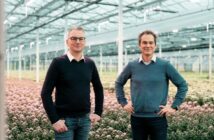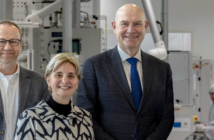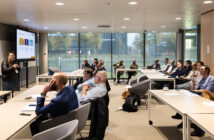Relevant for Brabant
The Brabant Development Agency (BOM) invests in companies with share capital and (subordinated) loans – not just for the financial returns but particularly for the social returns too. The companies in question are relevant for Brabant. Two promising examples.
Electrospinning is not a new technology. However, its application for biomedical purposes, for the production of ‘nano fibres’ which can be used to make implants, is just about ready for its market launch, says Jan van Helvoirt. And that is exactly what his company, IME Technologies from Geldrop, is working on.
‘My dream is to be the ASML of electrospinning equipment in a few years’ time’, says Jan van Helvoirt, CEO of IME
Electrospinning involves liquefying a polymer. In IME’s application, that liquid is pumped through a syringe, the opening of which is suspended in an electrical field, generated by means of a voltage of several kV or more. The electrostatic force draws the liquid from the syringe into a ‘collector’ and the resulting substance, which has a consistency something like chewing gum, is stretched into a very thin thread. ‘As thin as 1/500 of the thickness of a human hair’, says Van Helvoirt. On the collector, which can be a flat plate but also a revolving tube, the fibre is woven into a mould – for example, in the shape of a heart valve, a stent for an artery or a layer that can be used to cover a burn. ‘After it is introduced into the body, the body forms its own tissue between those fibres. If you make the threads from a biodegradable material, after some time you are left with a heart valve or a reinforcement to the artery consisting purely of material grown by the body itself, which helps prevent rejection and infections. This is what makes regenerative medicine so successful’, explains the IME CEO.
Six continents
And that exactly is the market his company is now targeting. As a spin-off of Eindhoven University of Technology and formerly part of the university’s holding company, the firm focused on performing all kinds of contract research in the first years after its establishment in 2008. As part of that, IME worked up the prototype – developed by co-founder Solberg – of an electrospinning machine into a test rig for biomedical research. Then, in 2012, the two entrepreneurs decided to focus completely on developing and building these devices, while also helping customers to configure the production process. They bought out the university and have since exchanged the campus for their own premises in Geldrop. Here, the devices are developed and assembled before being shipped to customers across six continents, says a proud Van Helvoirt: ‘We started out by selling to and providing the process support for laboratories at universities and knowledge institutes. But since then we have also supplied devices to the US firm HART for the production of windpipe implants and to a European customer for heart valve implants.’
Dream
For the time being, IME is aiming for a business model in which it offers that combination of equipment and support. ‘We now only develop customer-specific devices, and customers still really need our know-how in order to set up the process properly so that it can be reliably used for production runs of hundreds or thousands of identical products. But my dream is to be the ASML of electrospinning equipment in a few years’ time, able to install complete, reliable production lines for medical implants for customers. We are also considering setting up our own production line to mass-produce biomedical products for the smaller players in the market.’ So says Van Helvoirt, who hopes his workforce will have swollen from the current 12 people to 25 in five years’ time.
Promising
Precisely because long-term growth is the objective – and the firm is not looking for short-term working capital – IME (again) turned to BOM and investor TIIN Capital for additional share capital. ‘A loan’, says Ilse Massart, the BOM investment manager involved, ‘was also considered. But because the objective is to enter new markets and this is an investment with a higher risk profile than, for example, bank finance, we opted for shares and for the control you get as a shareholder.’ The fact that BOM took that step says everything about their confidence in and appreciation for the earnings model: ‘IME also serves an interest of society as a whole. Their regenerative medicine technology can significantly enhance the quality of life of many patients. It is a promising technology, and the growth we anticipate will also benefit a whole ecosystem of supplier firms. Besides, we have here two entrepreneurs who complement each other very well and have the ambition and drive to really make a success of it.’
Jan van Helvoirt expects to be knocking on BOM and TIIN’s doors again in future. ‘Because if we want to achieve our dream of building our own factory and production line to manufacture our devices, we will undoubtedly need much more money.’ BOM will be pleased to discuss it with them, says Ilse Massart.
Rising quality standards
The Eindhoven high-tech group One of A Kind Technologies consists of Crux Agribotics, Smart Vision Center, Beltech and VIMEC, firms specialising in vision technology. Crux Agribotics, for example, develops robotics and automation solutions for more efficient agricultural production with higher yields – for example, robots that can harvest, sort and pack 24 hours per day, that are able to identify diseases and non-conformities, and that do not bring viruses with them. VIMEC develops and manufactures vision technology for inspecting pharmaceutical glass (such as syringes, vials and ampoules) and Beltech does the same for all kinds of industrial applications, from inspecting engines through to checking weaving errors in carpets. Smart Vision carries a range of inspection cameras made by Cognex and installs and services them, using innovations from the other parts of the group, if necessary. ‘Worldwide, quality standards are rising. Customers do not tolerate manufacturing errors, and if they do occur they want the causes to be properly traceable. For this reason, our technology puts us in a growth market’, says CEO Alex Kind.
Examples
Two companies serve as an example for his growth strategy: Aalberts Industries and Lely. ‘Over the years, Aalberts has taken over hundreds of firms, with a particular eye for businesses that can reinforce one another – the way our businesses do too. For years Lely has invested a lot of money in development, laying the foundation for the worldwide success they now enjoy with their milking and manure robots. We invest a lot in R&D too.’
CEO Alex Kind of One of A Kind is pleased with the loan from BOM for commercial reasons. ‘What’s more, we can use this money to implement our growth plans.
Because getting a robot with computer vision to harvest cucumbers, say, does not happen by itself, Kind explains. ‘Unlike in the automotive or food industries, in the agricultural sector each product is different. No two cucumbers are the same, they are all in different places and sometimes they don’t even stay still. Nevertheless, the robot has to recognise the cucumber, so that the gripper can get hold of it. With Crux, we consciously chose cucumbers because they are green in a green environment. Our thinking was: we’ll start with the hardest thing there is, after that we’ll be able to handle anything.’
Professionalising
But the research done by Crux costs a lot of money, and there are not yet any sales to offset the investment. The other companies do generate turnover and a gross profit of around 20 percent, but the work there consists virtually exclusively of risky development projects that do not yield a return until the customer’s problem is actually solved. ‘We don’t just need money for innovation, but also to be able to professionalise. Because growth in itself causes inefficiency. Since 2012, we have grown from 10 to our current staff complement of 55, and we want that number to increase to 80 over the coming year. But you only benefit from the know-how of new employees if your existing employees know they have it, in other words if the know-how is properly assured in the system.’
Recognition
So it was gratifying that last year One of A Kind received a loan from the Brabant Development Agency (BOM). ‘Gratifying for commercial reasons. Because in order to qualify for a loan, the company and management need to go through an extensive selection process. The award of this loan is a recognition of our qualities. What’s more, we can use this money to implement our growth plans. We now have access to a reserve of money we can use if we need it. We will try to use it sparingly, though. We don’t want to dilute our ownership and we want to run up as few debts as possible. But this way we can grow, organically and by means of acquisitions. We are always looking for partnerships with other firms when we encounter capacity or competency issues. And yes, when we do so, we always check to see whether those partners are potential takeover candidates. We are very open about that.’
The loan which One of a Kind received from BOM Capital was a subordinated loan. They opted for a loan, explains Gert Jan Vaessen, investment manager at the development agency, because it means the entrepreneurs don’t have to dilute their own shareholdings. ‘And we chose a subordinated loan because the bank regards this type of loan as venture capital, which is almost equated to share capital, and therefore as shareholders’ equity. In this way, we boosted One of A Kind’s solvency, making it easier for the company to borrow additional funds from banks.’
Partnership
BOM dared to take this extra risk because the organisation ‘believes in the entrepreneurs’. Vaessen: ‘They are ambitious but also realistic. They are the type to
really go for it and at the same time they are professional. The latter is demonstrated by their very methodical, clear reports, strong customer focus and consideration for their own employees.’ BOM also got involved because the innovations which the One op A Kind group are working on are regarded as being ‘relevant for Brabant’. ‘In terms of employment, but also because their knowledge and expertise in vision technology are contributing significantly to the regional value chain. To this end, they are also looking to establish partnerships with other businesses in the region, which are resulting in innovations those firms could not have achieved on their own. At BOM, we are also concerned about this social return’, says Vaessen, who confirms that the faith invested in One of A Kind is already paying dividends in financial terms.





